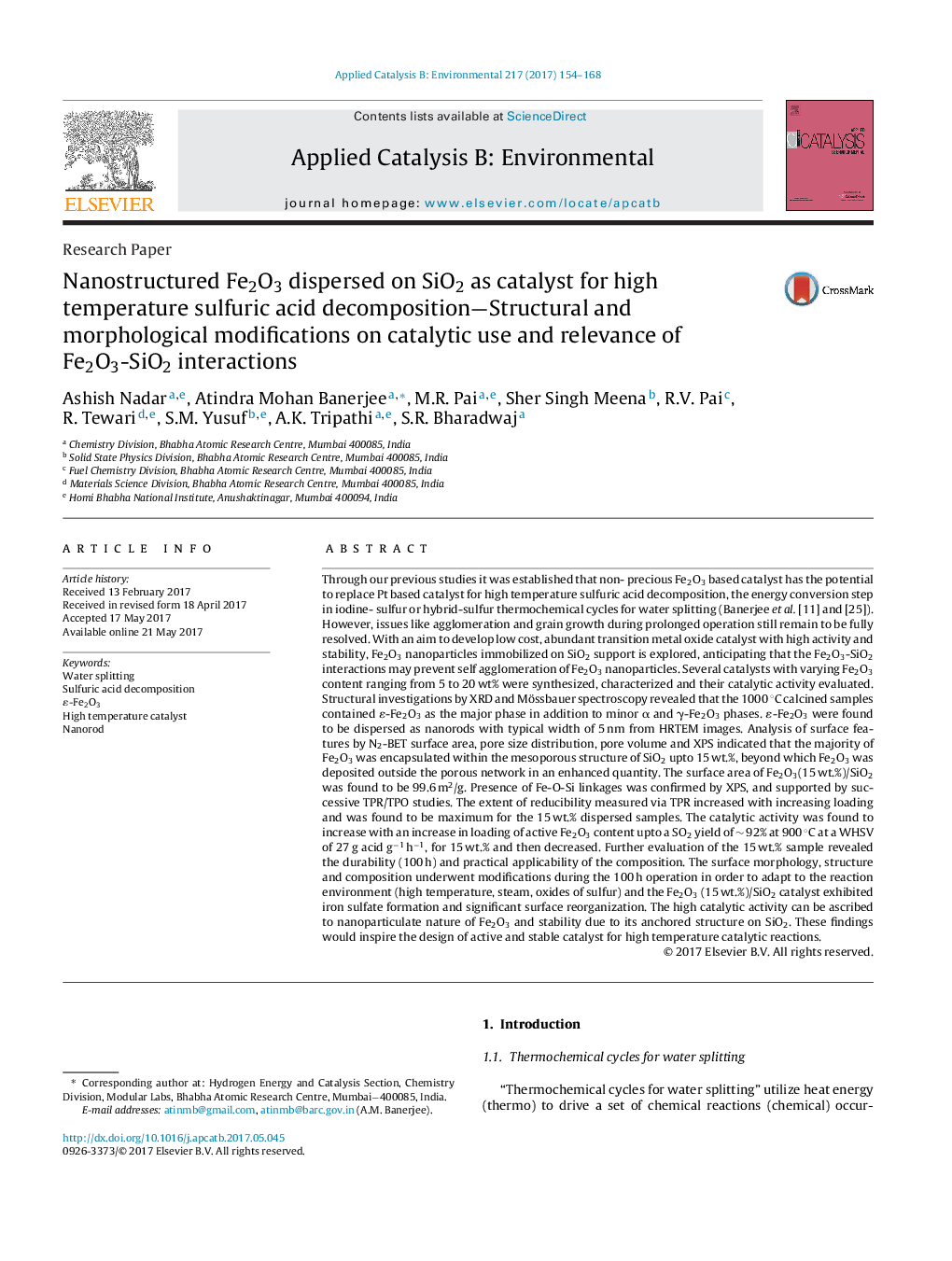| کد مقاله | کد نشریه | سال انتشار | مقاله انگلیسی | نسخه تمام متن |
|---|---|---|---|---|
| 6453927 | 1418803 | 2017 | 15 صفحه PDF | دانلود رایگان |

- Fe2O3 (5-20Â wt.%)/SiO2 catalyst evaluated for H2SO4 decomposition.
- Fe2O3 (15Â wt. %)/SiO2 exhibits superior redox properties and highest catalytic activity.
- Sustainable catalytic activity of Fe2O3(15 wt.%)/SiO2 for 100 h at 800 °C.
- Most probable mechanism proposed via spent catalyst characterization.
- Superior catalytic activity ascribed to the nanoparticulate nature of Fe2O3 and stability imparted by the Fe2O3- SiO2 interactions.
Through our previous studies it was established that non- precious Fe2O3 based catalyst has the potential to replace Pt based catalyst for high temperature sulfuric acid decomposition, the energy conversion step in iodine- sulfur or hybrid-sulfur thermochemical cycles for water splitting (Banerjee et al. [11] and [25]). However, issues like agglomeration and grain growth during prolonged operation still remain to be fully resolved. With an aim to develop low cost, abundant transition metal oxide catalyst with high activity and stability, Fe2O3 nanoparticles immobilized on SiO2 support is explored, anticipating that the Fe2O3-SiO2 interactions may prevent self agglomeration of Fe2O3 nanoparticles. Several catalysts with varying Fe2O3 content ranging from 5 to 20 wt% were synthesized, characterized and their catalytic activity evaluated. Structural investigations by XRD and Mössbauer spectroscopy revealed that the 1000 °C calcined samples contained ε-Fe2O3 as the major phase in addition to minor α and γ-Fe2O3 phases. ε-Fe2O3 were found to be dispersed as nanorods with typical width of 5 nm from HRTEM images. Analysis of surface features by N2-BET surface area, pore size distribution, pore volume and XPS indicated that the majority of Fe2O3 was encapsulated within the mesoporous structure of SiO2 upto 15 wt.%, beyond which Fe2O3 was deposited outside the porous network in an enhanced quantity. The surface area of Fe2O3(15 wt.%)/SiO2 was found to be 99.6 m2/g. Presence of Fe-O-Si linkages was confirmed by XPS, and supported by successive TPR/TPO studies. The extent of reducibility measured via TPR increased with increasing loading and was found to be maximum for the 15 wt.% dispersed samples. The catalytic activity was found to increase with an increase in loading of active Fe2O3 content upto a SO2 yield of â¼Â 92% at 900 °C at a WHSV of 27 g acid gâ1 hâ1, for 15 wt.% and then decreased. Further evaluation of the 15 wt.% sample revealed the durability (100 h) and practical applicability of the composition. The surface morphology, structure and composition underwent modifications during the 100 h operation in order to adapt to the reaction environment (high temperature, steam, oxides of sulfur) and the Fe2O3 (15 wt.%)/SiO2 catalyst exhibited iron sulfate formation and significant surface reorganization. The high catalytic activity can be ascribed to nanoparticulate nature of Fe2O3 and stability due to its anchored structure on SiO2. These findings would inspire the design of active and stable catalyst for high temperature catalytic reactions.
194
Journal: Applied Catalysis B: Environmental - Volume 217, 15 November 2017, Pages 154-168